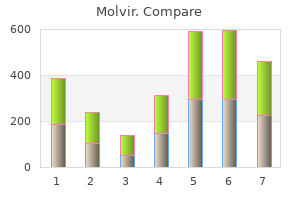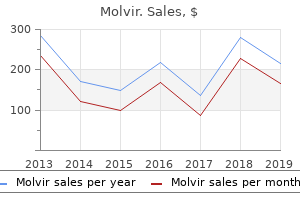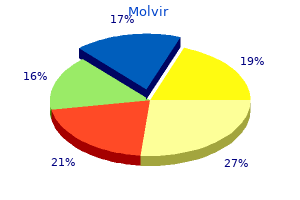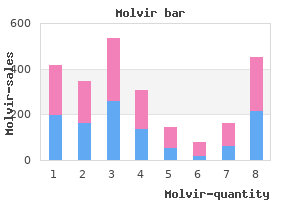"Cheap 200 mg molvir visa, hiv infection gif".
By: Q. Tragak, M.B. B.CH. B.A.O., M.B.B.Ch., Ph.D.
Deputy Director, Texas Tech University Health Sciences Center School of Medicine
An awake fiberoptic technique is selected and his airway is topicalized with aerosolized and viscous lidocaine chicken pox antiviral discount molvir 200mg otc. An infusion of dexmedetomidine is started during the topicalization and he is placed on nasal cannula at 4L/min hiv infection without symptoms order molvir 200mg without a prescription. He is sedated yet spontaneously ventilating while a fiberoptic bronchoscope is passed through the mouth and the vocal cords. Indications for Invasive Airway Management There are three general indications for invasive airway management: (1) the need for oxygenation, (2) the need for ventilation, or (3) the need for a patent airway (Table 1). Other specific indications for invasive mechanical ventilation are hemodynamic instability, hypoxic or hypercapnic respiratory failure, or the need for an artificial airway consequent to airway edema, copious secretions, altered mental status, or injuries to the head and neck. A more comprehensive list of specific indications by category is presented in table 1. Critically ill patients may benefit from intubation for any combination of these indications. Additionally, bellows fatigue and increased elastic work of breathing may result in alveolar hypoventilation (need for ventilation) while cranial nerve involvement can severely impair the ability to control and coordinate the muscles of the upper airway (need for a patent airway). Intubation bundled checklists aid operators in maintaining a high-level of advanced preparation (Table 2). The external airway examination attempts to predict the ease of mask ventilation and intubation an operator will encounter with Table 4. Rapid sequence induction: propofol, etomidate or ketamine followed immediately by succinylcholine in the absence of hyperkalemia, severe acidosis, neuromuscular disease, spinal cord trauma or burn injury > 48 hour. Cricoid pressure (Sellick maneuver) until confirmation of secure airway After Intubation 1. Adapted from Barasch et al (12) 131 Patient Considerations In all critically ill patients for whom invasive ventilation may be a necessary therapeutic step, perform an external airway examination during the routine physical exam. With familiarity of patient-specific factors already in mind, an urgent or emergent airway management plan may be more efficiently tailored to meet each patient. Classic risk factors for a difficult airway (Table 3), including Mallampati grading (Figure 1), (5) have been shown to have poor positive and negative predictive value in forecasting a difficult intubation or laryngeal view on direct laryngoscopy. Whenever possible, discuss the risks and benefits of intubation and mechanical ventilation with the patient and his or her designated healthcare representatives. An awake intubation is generally performed with a fiberoptic this work by en. Junior operator * Total *Junior operator defined by fewer than 12 months anesthesia-specific airway training (10) Scored from 0 to 12. Adapted from DeJong et al (4) Routine asleep intubation is performed when the operator is Points 5 2 1 1 1 1 1 reasonably confident that the patient can be ventilated by mask and intubated, and when there is low concern for aspiration of gastric contents during the procedure. In this approach, the ability to bag mask ventilate the patient is verified before a paralytic is administered. Patient positioning should be optimized prior to intubation to the extent possible permitted by time and clinical status. The technique also requires time and a patient who is adequately cooperative and clinically stable. It is generally reserved for patients with significant head and neck pathology, or oropharyngeal obstruction, including severely limited oral opening. Sedation with minimal changes in respiratory drive or muscle tone can be achieved with low-dose infusions of either dexmedetomidine or ketamine. A surgical airway is always a viable option if no other airway can be established. Site-specific protocols for establishing a surgical airway, including team member selection, should be reviewed at the outset of an airway management plan. An alternative technique should be employed immediately if laryngoscopy reveals a Grade 4 view, whether it is due to anatomy or blood or secretions in the airway.

Monitor O2 saturation and lung compliance after each dose antiviral movie 200 mg molvir sale, and adjust oxygen therapy and ventilator pressure as necessary hiv infection europe buy 200 mg molvir with mastercard. Suction infant prior to administration and 1 hr after surfactant instillation (unless signs of significant airway obstruction). Each vial of drug should be slowly warmed to room temperature and gently turned upside down for uniform suspension (do not shake) before administration. Unopened vials that have been warmed to room temperature (once only) may be refrigerated within 24 hr and stored for future use. Major adverse events include tremor, headache, insomnia, diarrhea, constipation, hypertension, nausea, and renal dysfunction. Hypokalemia, hypomagnesemia, hyperglycemia, confusion, depression, infections, lymphoma, liver enzyme elevation, and coagulation disorders may also occur. Calcium channel blockers, imidazole antifungals (ketoconazole, itraconazole, fluconazole, clotrimazole, and posaconazole), macrolide antibiotics (erythromycin, clarithromycin, and troleandomycin), cisapride, cimetidine, cyclosporine, danazol, herbal products containing schisandra sphenanthera extracts, methylprednisolone, and grapefruit juice can increase tacrolimus serum levels. In contrast, carbamazepine, caspofungin, phenobarbital, phenytoin, rifampin, rifabutin, and sirolimus may decrease levels. Tacrolimus therapy generally should be initiated 6 hr or more after transplantation. Do not use in children < 2 yr, immunocompromised patients, or patients with occlusive dressings (promotes systemic absorption). Approved as a second-line therapy for short-term and intermittent treatment of atopic dermatitis for patients who fail to respond or do not tolerate other approved therapies. Skin burn sensation, pruritus, flu-like symptoms, allergic reaction, skin erythema, headache, and skin infection are the most common side effects. Use thin film (2 mg/cm2) for cream or gel dosage form and small amount for foam dosage form. The cream dosage form may also be used the same way as the gel, but it is currently labelled for use in adults (18 yr). Pregnancy testing 2 wk prior to use and initiation of use during menstrual period have been recommended. Common side effects include erythema, dry skin, skin irritation/pain, pruritus, and worsening of psoriasis. The foam dosage form is flammable; avoid fire, flame, or smoking during or immediately after use. Nervousness, tremor, headache, nausea, tachycardia, arrhythmias, and palpitations may occur. Paradoxical bronchoconstriction may occur with excessive use; if it occurs, discontinue drug immediately. Also not recommended for use in pregnancy because these side effects may occur in the fetus. May decrease the effectiveness of oral contraceptives, increase serum digoxin levels, and increase effects of warfarin. Use with methoxyflurane increases risk for nephrotoxicity and use with isotretinoin is associated with pseudotumor cerebri. Immediate release: Elixir (Elixophyllin): 80 mg/15 mL (473 mL); may contain up to 20% alcohol. Sustained/extended release (see remarks): Tabs: Q12 hr dosing (Theochron and generics): 100, 200, 300, 450 mg Q24 hr dosing (generics): 400, 600 mg Caps (Q24 hr dosing: Theo-24): 100, 200, 300, 400 mg Sustained-release forms should not be chewed or crushed.

Poisoning mortality in United States: comparison of national mortality statistics and poison control center reports antiviral used to treat parkinson's discount 200mg molvir mastercard. Advisory Committee on Childhood Lead Poisoning Prevention of the Centers for Disease Control and Prevention antiviral classification buy 200 mg molvir otc. Diphenhydramine and dimenhydrinate poisoning: An evidence-based consensus guideline for out-of-hospital management. Pharmacology, pathophysiology and management of calcium channel blocker and beta-blocker toxicity. Laundry detergent "pod" ingestions: a case series and discussion of recent literature. Iron ingestion: an evidencebased consensus guideline for out-of-hospital management. Acute toxicity due to the confirmed consumption of synthetic cannabinoids: clinical and laboratory findings. Consent Before performing any procedure, it is crucial to obtain informed consent from the parent or guardian by explaining the procedure, the indications, any risks involved, and any alternatives. All invasive procedures involve pain, risk for infection and bleeding, and injury to neighboring structures. Sedation and analgesia should be planned in advance, and the risks of such explained to the parent and/or patient as appropriate. In general, 1% lidocaine buffered with sodium bicarbonate is adequate for local analgesia. Proper sterile technique is essential to achieving good wound closure, decreasing transmittable diseases, and preventing wound contamination. Introduction to Ultrasound Ultrasound has become an increasingly important bedside diagnostic and procedural aid. Ultrasound can improve visualization of subcutaneous structures noninvasively during procedures and improve precision. Ultrasound caveats important for certain procedures are noted below, where applicable. Linear transducers use high frequencies to produce high resolution images and are primarily used for procedures in pediatrics. A wide area of contact at the skin surface facilitates needle placement in procedures. Curvilinear transducers use low to midrange frequencies and permit deep structure visualization. Though they provide a wide area of skin contact to facilitate procedures near concave and convex surfaces, larger curvilinear probes are difficult to use in small children. There are a variety of other probes (phased-array, microconvex) that generate sector shaped images but are predominantly used for diagnostic purposes. Do not clean probes with chlorhexidine, isopropyl alcohol, or alcohol-containing cleaners as they will damage the probe. Ensure adequate contact by using enough ultrasound gel and applying comfortable pressure on the skin. Depth: Adjust to visualize structure of interest and at least a centimeter of tissue below that structure. Indications: Blood sampling in infants for laboratory studies less affected by hemolysis. Puncture heel using a lancet on the lateral part of the heel, avoiding the posterior area. Puncture finger using a lancet on the palmar lateral surface of the finger near the tip. Wipe away the first drop of blood, and then collect the sample using a capillary tube or container. Alternate between squeezing blood from the leg toward the heel (or from the hand toward the finger) and then releasing the pressure for several seconds. Indications: Blood sampling and access to peripheral venous circulation to deliver fluid, medications, or blood products. After removing tourniquet, attach a syringe and apply gentle negative pressure to withdraw blood for serum sampling.

Increased sulfuric acid (1) Decreased acid excretion (2) Acute and chronic renal failure Nonanion gap metabolic acidosis (hyperchloremic metabolic acidosis) 1 hiv infection bone marrow molvir 200mg with visa. Hyperalimentation *Note: A large osmolar-gap acidosis can be seen in both methanol and ethylene glycol intoxication and hiv infection impairs what type of immunity purchase 200mg molvir with visa, when present, is suggestive of acute intoxication. Prevention of hyponatremia during maintenance intravenous fluid administration: a prospective randomized study of fluid type versus fluid rate. Hypotonic versus isotonic maintenance intravenous fluid therapy in hospitalized children: a systematic review. Hypotonic versus isotonic fluids in hospitalized children: a systematic review and meta-analysis. Dehydration: isonatremic, hyponatremic, and hypernatremic recognition and management. At least 1 episode of incontinence per week bowel syndrome: after the acquisition of toileting skills 1. History of painful or hard bowel obstruct the toilet movements Accompanying symptoms may include 5. Presence of a large fecal mass in the irritability, decreased appetite, and/or early rectum satiety, which may disappear immediately 6. History of large-diameter stools that following passage of a large stool may obstruct the toilet. Modified from Constipation Guideline Committee of the North American Society for Pediatric Gastroenterology, Hepatology and Nutrition. Infection:Herpesvirus,hepatitisA,hepatitisB,adenovirus, cytomegalovirus,Epstein-Barrvirus,enterovirus,humanherpes Chapter 12 Gastroenterology 327 b. Managing acute gastroenteritis among children: oral rehydration, maintenance, and nutritional therapy. Constipation Guideline Committee of the North American Society for Pediatric Gastroenterology, Hepatology, and Nutrition. Fecal calprotectin and lactoferrin as noninvasive markers of pediatric inflammatory bowel disease. Pediatric gastroesophageal reflux clinical practice guidelines: joint recommendations of the North American Society of Pediatric Gastroenterology, Hepatology, and Nutrition and the European Society of Pediatric Gastroenterology, Hepatology, and Nutrition. Eosinophilic esophagitis in children and adults: a systematic review and consensus recommendations for diagnosis and treatment. Guideline for the evaluation of cholestatic jaundice in infants: recommendations of the North American Society for Pediatric Gastroenterology, Hepatology and Nutrition. Continuous technologic advances have brought a constantly evolving field to the forefront of medical research and to the bedside of the everyday pediatric patient. Genetics is best considered in two broad categories: metabolism and dysmorphology. When considering a particular diagnosis, a complete patient history, including details of conception, pregnancy, prenatal screening and diagnostic studies, delivery, postnatal growth, development, and a three-generation family history in the form of a pedigree should accompany a comprehensive physical examination. Some, like ornithine transcarbamylase deficiency and mucopolysaccharidosistype2(Huntersyndrome),areX-linked. The presentationofsmallmolecule(metabolic)diseasesinneonatestends tobenonspecific,andmayincludelethargy,irritability,seizures, hypotonia, poor feeding, hypoglycemia, vomiting, and temperature instability. After the neonatal period, the presentation may include recurrent vomiting, lethargy progressing to coma, or organ dysfunction. For the diseases included in this handbook, please see the sections on "Evaluation"and"TreatmentofMetabolicCrisis"forempiric management;specialconsiderationsarelistedundereachdisease. Anaffectedcouple(eachbeingacarrier)hasa25%chanceofhaving anaffectedchild,a25%chanceofhavinganunaffected child and a 50%chanceofproducingacarrieroftheconditionwitheach pregnancy. Twocopiesofthesamegenemaybefunctionallyequivalent,butmay be expressed or silenced depending on the parent of origin of the chromosome. Uniparental disomy is a rare occurrence in which one inherits both copies of a chromosome pair from one parent. Thiscanresultinautosomalrecessive disease since any change in an allele is present on both copies of the gene. Thiscanresultindiseasesof imprinting, since only one parent contributes to the epigenetic pattern.
Generic 200mg molvir visa. WOOW!! Virus HIV bisa di DELETE untuk pertama kalinya.

When taken up by mitochondria hiv transmission route statistics buy molvir 200mg fast delivery, free fatty acid chains undergo beta oxidation hiv infection animation video order molvir 200mg visa, a process that produces acetyl CoA and hydrogen. Carbohydrates are composed of carbon, hydrogen, and oxygen and classified on the basis of the number of sugar molecules that compose the compound (monosaccharide, disaccharide, or polysaccharide). Efficiency is the proportion of total available energy that is used for work or is stored for future use. Fat is a more efficient fuel source during low-level activities because it is more readily available through fat stores and lipolysis. Energy produced from 1 g of fatty acids is 9 kcal compared with 4 kcal/g from carbohydrate or protein. When exercise intensity reaches a particular level, blood flow to the exercising muscles becomes inadequate to provide the necessary O2. This is termed the anaerobic threshold and is the point at which anaerobic pathways become the primary source of energy production. It is composed of a ribose sugar backbone, a nitrogen and carbon chain, adenine, and three phosphate molecules. Aerobic metabolism is therefore limited by the function of the cardiovascular, respiratory, and musculoskeletal systems, in addition to readily available supplies of O2. Although submaximal activity performed for an extended period primarily taxes the aerobic system, greater-intensity activity performed for a shorter period taxes both aerobic and anaerobic pathways, and near-maximal activity for an even shorter period relies almost solely on anaerobic means for fuel. The primary sources of fuel driving the aerobic system are carbohydrates and fats. Fat molecules, or triglycerides, are composed of one glycerol molecule and three fatty acid chains. Carbohydrates are primarily used during more intense activities of shorter duration activities. As activity level increases, a shift from the utilization of fats to more carbohydrates occurs to meet the increasing energy demands (Figure 4-4). The Frank-Starling mechanism is a mechanical property of cardiac muscle stating that the regulation of blood flow to working muscles. Evidence-Based Clinical Application: Assessing Aerobic Capacity Aerobic capacity is the ability of the cardiovascular system to deliver and use O2. Assessment of aerobic capacity can be determined via direct, maximal test measures or indirect, submaximal testing. Older adults have reduced exercise capacity; therefore when measuring O2 uptake, a longer warm-up, smaller increments of speed/slope per stage, and lower work peak rate should be used. As a result of reduced exercise capacity with age, some health care professionals prefer to predict aerobic capacity on the basis of submaximal exercise intensity. During forced exhalation, a sudden increase in intra-abdominal and intrathoracic pressures is produced by the contractions of the abdominal and respiratory muscles. In addition, compression of the aorta leads to stimulation of the baroreceptors, producing a reflex-induced bradycardia to compensate for the increased pressures. However, the Valsalva technique can help protect against injury during heavy weight lifting. The supporting ligaments of the spine can only support 4 to 5 lb of pressure before failing. Individuals are coached to perform the maneuver during the work phase of the lift. Individuals should inhale before the exercise, hold their breath through the most difficult phase of the lift, and exhale to complete the lift. Because the consequences of improper breathing with weight lifting can be severe, proper education is essential. The rise in circulatory blood volume increases the stretch, or length, on ventricular myocardial muscle. The greater muscle stretch yields a more forceful contraction during systole, ejecting a greater volume of blood with each heart beat. During resistance training, individuals often hold their breath to generate greater force.

